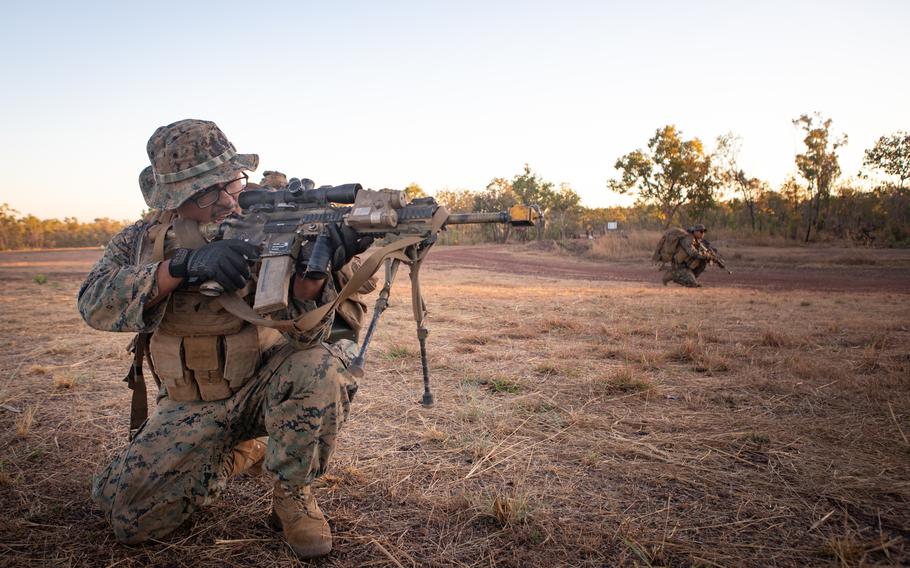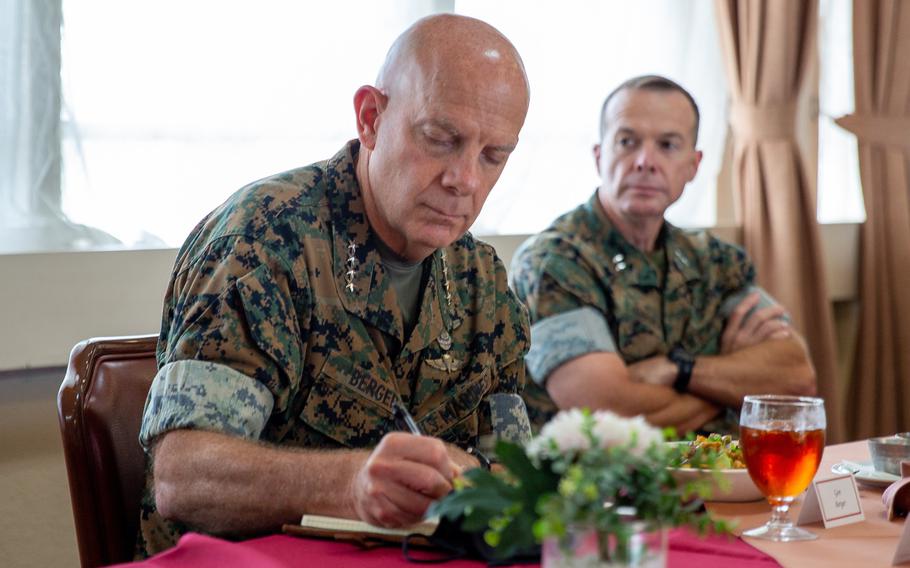
Marines with Company B, 1st Battalion, 7th Marine Regiment, Marine Rotational Force Darwin conduct an airfield seizure exercise at Mount Bundey Training Area, Australia, July 21, 2021. The exercise used concepts from the Marine Corps' Force Design 2030, which utilizes smaller, more mobile fighting formations. (Micha Pierce/U.S. Marine Corps)
The Marine Corps is moving forward with a controversial plan that has mothballed tanks in favor of smaller, more mobile fighting formations, despite a backlash from some acclaimed retired generals.
Marine Corps Commandant Gen. David Berger on Monday released an update to his Force Design 2030 concept, which amounts to some of the most significant changes in the service in a generation.
The Corps is two years into the initiative, which has seen it get rid of hundreds of tanks and cut back on towed cannon artillery and significant numbers of helicopter units. The aim is to set up the service to counter China more effectively in the years to come.
“We are modernizing the Marine Corps using the (People’s Republic of China) as a benchmark,” Berger wrote in the update.
But the speed of the Corps’ transformation has rattled some former Marine brass.
The pushback comes from a group of some 30 retired generals, Politico reported in April, including Jim Mattis and Joe Dunford — two of the biggest names in recent Marine Corps history. Neither Mattis nor Dunford have commented publicly on their views of the force structure changes.
Critics are concerned that the Corps could be putting at risk its traditional role of performing global crisis response operations by divesting armor and reducing the size of its battalions.
Retired Lt. Gen. Paul K. Van Riper wrote in a March op-ed in the Marine Corps Times that the Corps is sacrificing its combined arms capability to support maritime denial and control campaigns with anti-ship missiles.
“It will be a force shorn of all its tanks and 76% of its cannon artillery, and with 41% fewer Marines in its infantry battalions,” Van Riper wrote. “To make the situation even worse, there will be 33% fewer aircraft available to support riflemen on the ground.”
In his update to Force Design 2030, Berger notes the criticism from “stakeholders.”
“We have consistently said that a modernized Marine Corps must still be capable of performing global crisis response operations,” Berger wrote, in what appears to be a nod to his critics.
“Regardless, we must do better in explaining to all stakeholders the analytic rigor underpinning our Force Design choices, and how a modernized Marine Corps will perform our traditional roles and functions in the future.”

Marine Corps Commandant Gen. David Berger visits Marine Corps Air Station Futenma on Okinawa, Japan, Sept. 11, 2021. Berger on Monday released an update to his Force Design 2030 concept, which amounts to some of the most significant changes within the service in a generation. (Nickolas Beamish/U.S. Marine Corps)
Berger’s changes center on his concept of “stand-in forces,” or smaller, more nimble units arranged to help the military in areas such as reconnaissance and counter-reconnaissance.
The concept intends to provide the Pentagon with a hard-to-detect force that could help find and sink enemy vessels at sea while maneuvering with greater range on land.
“Infantry will continue to locate, close with, and destroy adversaries through fire and maneuver, but the range of options for how to locate, how to close, and how to destroy is expanding,” Berger wrote. “These new means give infantry increased lethality and greater range of purpose.”
Advanced long-range weaponry from adversaries such as Russia and China means that Marines need to operate in a more dispersed manner, with a reduced “logistical footprint and low signature,” Berger continued.
Key for small units is that they possess long-range precision fires capability, such as light miniature attack munitions, which “shortens the kill chain dramatically and enables that unit to out cycle the enemy,” the update says.
The effectiveness of a smaller, more mobile force against a hulking adversary has been on display for the past couple of months in Ukraine, where Russian tanks and armor have at times been easy targets for lighter Ukrainian forces on the move.
Berger doesn’t mention the war in Ukraine directly in his plan, but he noted that these “observations are also being demonstrated on global battlefields for all to see.”